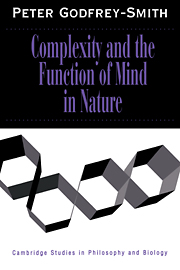2 - Externalism and internalism
Published online by Cambridge University Press: 05 June 2012
Summary
Some basic explanatory forms
The environmental complexity thesis about cognition asserts a link between certain capacities of organic systems and a specific feature of these systems' environments. This is a familiar pattern of explanation. It exemplifies one of the basic stances or approaches that can be taken in investigating organic properties. The internal is understood in terms of its relation to the external. If a causal explanation is involved, the channel of causal influence goes “outside-in.”
One of the aims of this book is getting a better understanding of this general pattern of explanation, and understanding some versions of the environmental complexity thesis as instances of this pattern.
Most generally, the term “externalist” will be used for all explanations of properties of organic systems in terms of properties of their environments. Explanations of one set of organic properties in terms of other internal or intrinsic properties of the organic system will be called “internalist.”
These terms “externalist” and “internalist” apply to our explanations of properties of organic systems, not to the organic systems themselves. But an externalist claim can be true or false, and if a system, or some aspect of it, really is controlled entirely or for the most part by events in its environment, then an externalist pattern of explanation applies to it.
This chapter will mainly be concerned with the relations between internalism and externalism. A third basic pattern of explanation will be discussed in detail in Chapter 5, but I will introduce it now.
Information
- Type
- Chapter
- Information
- Complexity and the Function of Mind in Nature , pp. 30 - 65Publisher: Cambridge University PressPrint publication year: 1996
